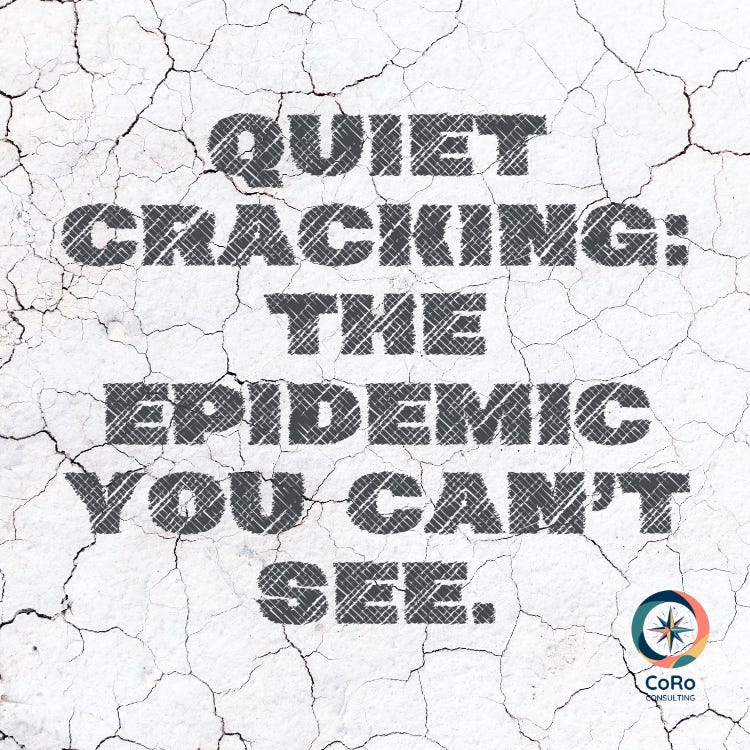We’ve all heard of quiet quitting—when employees stop going above and beyond and do just enough to survive. But there’s a new epidemic sweeping workplaces, and it’s quieter, scarier, and far more expensive.
It’s called quiet cracking.
Quiet cracking isn’t burnout’s dramatic blaze-out—no resignation letter dropped on Slack, no viral “I quit” post. It’s subtler, almost invisible. It’s the moment people keep showing up, keep smiling, keep sending emails… but they’ve already broken inside.
It’s the teammate who logs onto Zoom but never turns their camera on anymore.
The leader who delivers the town hall but whose eyes look hollow.
The once-vibrant colleague who used to light up brainstorming sessions but now just nods along.
That’s quiet cracking. And it’s everywhere.
The Numbers Behind the Cracks
Don’t mistake this for a soft concept; it’s measurable, and the data should scare every leader paying attention.
54% of U.S. workers say they’ve experienced quiet cracking recently (TalentLMS, 2025).
1 in 5 say it happens frequently or constantly. That means in a team of 10, two people are already cracked.
Globally, only 21% of employees are engaged—which means nearly 8 out of 10 are checked out, surviving instead of thriving (Gallup, 2023).
The cost? Disengaged employees are draining $8.8 trillion annually—almost 9% of the entire world’s GDP (Gallup, 2023).
This is not background noise. It’s an economic and cultural crisis hiding in plain sight.
Why Quiet Cracking Happens
Here’s the truth: people don’t crack because they don’t care. They crack because they’ve cared too much, for too long, without being cared for in return.
Job insecurity makes them hold their breath instead of raising their hand.
Stalled growth convinces them to shrink their dreams.
AI anxiety whispers that their work, and their worth, might be replaced.
Unclear expectations leave them second-guessing themselves daily.
Over time, silence becomes survival. But survival mode is not thriving. It’s how teams slowly bleed out their best people, their creativity, and their momentum.
How We Crack the Epidemic: CARE in Action
This is exactly why I built CoRo Consulting and the CARE framework. Quiet cracking is invisible, but it’s not inevitable.
Clarity: Cracks widen when success isn’t defined. We help leaders set clear expectations so teams stop wasting energy guessing.
Authenticity: Cracks deepen when people can’t be real. We create spaces where leaders and teams can tell the truth—especially when it’s hard.
Recognition: Small wins matter. When effort goes unnoticed, people shrink. We help leaders turn gratitude into fuel for momentum.
Empathy: Stress doesn’t disappear when ignored. Empathetic leadership is about seeing the human behind the role and responding with compassion.
When organizations operationalize CARE, they don’t just patch cracks; they build cultures strong enough to bend without breaking.
My Why
I’ve led teams in high-pressure environments where trust was the only currency—first as a Naval Officer during Operation Enduring Freedom, and now as the founder of CoRo Consulting. I’ve also worked inside organizations where performance mattered more than people.
Both experiences taught me the same truth: when people feel safe, seen, and celebrated, they don’t crack—they rise.
That’s why I’m on a mission to dismantle crumb culture and help leaders build workplaces where wholeness and high performance can coexist.
A Bold Invitation
Quiet cracking is real. It’s happening in your teams, whether you see it or not. The question is: what will you do about it?
If you’re ready to stop the cracks before they spread, let’s talk. I’m offering 60-minute Q4 Reset sessions for teams —a chance to surface the cracks, realign on priorities, and recommit to finishing the year strong.
💌 Reply to this post or email me at coco@coroconsulting.co to book your session.
✨ Because when leaders choose Clarity, Authenticity, Recognition, and Empathy… we don’t just prevent cracks. We create cultures that can withstand anything.


